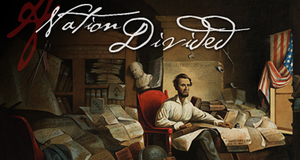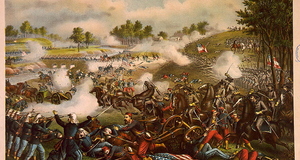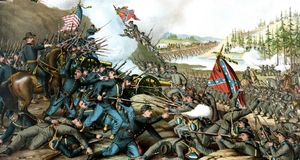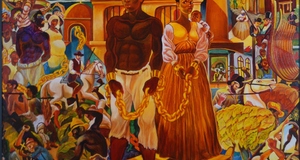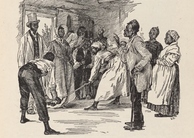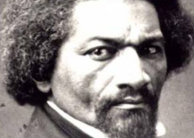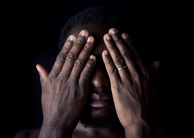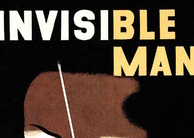Featured Article:The "Roving Ambassador:" Bayard Rustin's Quaker Cosmopolitanism and the Civil Rights Movement
By
2014, Vol. 6 No. 04 | pg. 4/4 | « Concluding RemarksRustin did recover from his humiliating dismissal from FOR: in 1953, the War Register's League (WRL) recruited him to organize political events that would reveal the full extent of what Rustin had studied abroad in his Indian and West African tours, and, by extension, the dovetailing of Quaker and Gandhian pacifist tactics. Shortly after being hired, Rustin fully embraced the notion of the Weltbürger activist by returning to Africa on another Quaker lecture circuit and anti-nuclear arms campaigns. But the culmination of Rustin's political experiences abroad was expressed in his alliance with Dr. Martin Luther King Jr. and the expert organization of the momentous March on Washington. Rustin left the WRL to advise King on Gandhian pacifist tactics shortly after the latter was elected to director of the Southern Christian Leadership Conference on February 14, 1957 (SCLC). In an interview years latter, Rustin recalls meeting King in his home for the first time: "I said [. . .] watch out! There's a gun on that chair!" (Rustin Audio). In the time leading up to the march, Rustin had exhorted King to dispose of his weapons: "I think it's fair to say that Dr. King's view of non-violent tactics was almost non-existent when the boycott began. In other words, Dr. King was permitting himself and his children and his home to be protected by guns." One night after Rustin had left the King residence, a boy delivering a telegram was almost gunned down by King's body guards: "That incident," said Rustin, "brought King up against the implications of gun violence. We talked many hours about tactics of nonviolence and I feel Dr. King learned something from our discussions" (Rustin Audio). In this way, the persuasive rhetoric Rustin had employed overseas in India and West Africa similarly convinced King that the success of the civil rights movement relied on the implementation of Gandhian tactics. 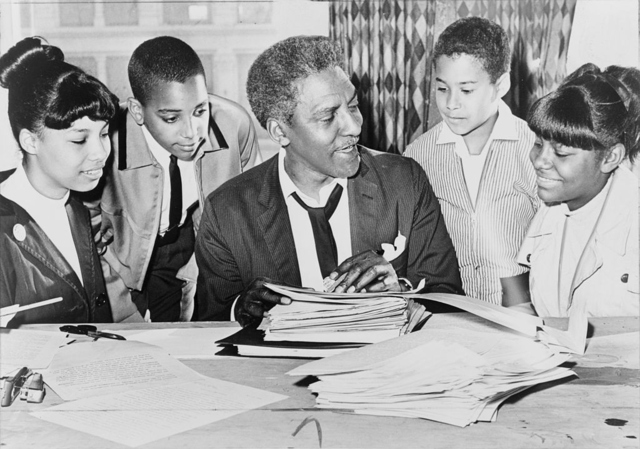
Bayard Rustin speaking with (left to right) Carolyn Carter, Cecil Carter, Kurt Levister, and Kathy Ross, before a demonstration in 1964. In January 1963, Randolph commissioned Rustin to draft plans for a mass Gandhian march that would protest black unemployment and poverty. The news of Rustin's involvement in the march's organization inaugurated debate. Many civil rights organizers decried Rustin's past (though long severed) ties with the communist movement and his homosexuality. South Carolinian Senator Strom Thurmond leveled the most severe obloquy against Rustin's association with the movement, denouncing him as a "Communist, draft-dodger, and homosexual" (Anderson 251). To which Rustin responded in a letter to the press dated August, 14, 1963: "I am not the first of my race to have been falsely attacked by spokesmen of the Confederacy. [. . .] By religious training and philosophy, I am disinclined to put myself in the position of having to defend my own moral character" (Rustin 266). Most notably, King privately expressed his reservations for Rustin's association with the march, but remained convinced of his capability to mobilize the enormous task. Indeed, Rustin's participation proved to be a success when on August, 28, 1963, over 250,000 people gathered before the Lincoln Memorial. Such a mass demonstration expressed the spirit of Quaker nonviolence and the commitment of thousands to those Christian ideals. In an moving account of that day, Rustin recalls a moment with A. Philip Randolph: "I could see he was tired. I said to him, 'Mister Randolph, it seems that your dream has come true.' And when I looked into his eyes, tears were streaming down his cheeks" (263). In conclusion, this paper has outlined interconnections between Quaker philosophy, Kantian cosmopolitanism and Rustin's global peace activism. His activism in America and abroad helped to forge a vital connection between global and national liberation movements. On a deeper level, Rustin's persistent efforts to synthesize Quaker/Gandhian principles, Western/Eastern philosophies, black/white activism points to a globalized interracial religion that dismantles binaries in order to present a broader picture of global interconnectedness and interdependency. Moreover, Rustin's iterations of Quaker cosmopolitanism suggests that struggles for liberation must never be treated as isolated, private struggles, but as global problems that invite the aid and compassion of others. That Rustin's homosexuality pushed him to the margins of political oblivion is a testament to the ways in which today's society is still feeling the reverberations of the civil rights movement. The historical narrative of Rustin's global activism voices a forceful call for Quaker demonstrations of tolerance and inclusivity as the LGBTQ community, in America and abroad, struggles to secure legal rights and social recognition.ReferencesAnderson, Jervis. Bayard Rustin: Troubles I've Seen: A Biography. New York: HarperCollins Publishers, 1997. Print. Brooks, Thomas R. Walls Come Tumbling Down: A History of the Civil Rights Movement, 1940-1970,. Englewood Cliffs, NJ: Prentice-Hall, 1974. Print. Carbado, Devon W., and Donald Weise."The Civil Rights Identity of Bayard Rustin." Texas Law Review. 82 (2004): 1135-1195. Academic Search Elite.OSU-Tulsa Lib.,Tulsa, OK. 26 Nov 2007 http://www.ebscohost.com. Web. Danielson, Leilah C. ""In My Extremity I Turned to Gandhi": American Pacifists, Christianity, and Gandhian Nonviolence, 1915–1941." Church History 72.02 (2003): 361 - 375. Print. Danielson, Leilah. "It Is a Day of Judgment": The Peacemakers, Religion, and Radicalism in Cold War America." Religion and American Culture: A Journal of Interpretation 18.2 (2008): 215-48. Web. D'Emilio, John. Lost Prophet: The Life and times of Bayard Rustin. New York: Free, 2003. Print. Fairclough, Adam. "Martin Luther King Jr. and the Quest for Nonviolent Social Change." Phylon (1960-) 47.1 (1986): 1-15. Print. Gaines, Kevin. "A World to Win: The International Dimension of the Black Freedom Movement." OAH Magazine of History Social Movements in the 1960s 20.5 (2006): 14-18. Print. Hardiman, David. Gandhi in His Time and Ours. New Delhi: Permanent Black, 2003. Print. Hertzberg, Hendrik. "Offenses." The New Yorker. Conde Nast, 17 Sept. 2007. Web. 13 May 2013. http://www.newyorker.com/talk/comme2007/09/17/070917taco_talk_hertzberg. Jakle, John A. The Tourist: Travel in Twentieth-century North America. Lincoln: University of Nebraska, 1985. Print. Janney, Samuel Macpherson. The Life of George Fox; with Dissertations on His Views concerning the Doctrines, Testimonies and Discipline of the Christian Church. Philadelphia: Lippincott & Grombo, 1853. Print. Kapur, Sudarshan. Raising up a Prophet: The African-American Encounter with Gandhi. Boston: Beacon, 1992. Print. Louden, Robert B. Kant's Human Being: Essays on His Theory of Human Nature. New York: Oxford UP, 2011. Print. Prashad, Vijay. "Black Gandhi." Social Scientist 37.1/2 (2009): 3-20. Print. Rustin, Bayard. "Bayard Rustin – Who Is This Man?" State of the Re:Union, 2011. http:// stateofthereunion.com/home/season-2/bayard-rustin. Audio. Rustin, Bayard. I Must Resist: Bayard Rustin's Life in Letters. Ed. Michael G. Long. San Francisco: City Lights, 2012. Print. Suggested Reading from Inquiries Journal
Inquiries Journal provides undergraduate and graduate students around the world a platform for the wide dissemination of academic work over a range of core disciplines. Representing the work of students from hundreds of institutions around the globe, Inquiries Journal's large database of academic articles is completely free. Learn more | Blog | Submit Latest in African-American Studies |








